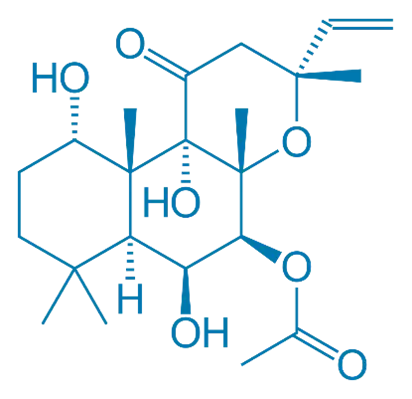- Industrial production, estimation and utilization of phytoconstituents involve extraction, purification, and quantification using modern techniques like HPLC, GC-MS, and spectroscopy.
- Industrial production, estimation and utilization of phytoconstituents support drug development, nutraceuticals, cosmetics, and functional foods for therapeutic benefits.
Forskolin

Industrial Production
Source:
- Forskolin is primarily extracted from the roots of Coleus forskohlii, a member of the mint family.

Extraction Process:
- Harvesting: Roots are harvested, cleaned, and dried.
- Extraction: The dried roots undergo solvent extraction, typically using ethanol or methanol.
- Purification: The crude extract is subjected to chromatography (e.g., column chromatography) to isolate forskolin.
- Refinement: Further purification steps, such as recrystallization, ensure high purity suitable for pharmaceutical use.
Alternative Production:
- Biotechnological Approaches: Tissue culture and genetic engineering are being explored to enhance yield.
- Semi-synthesis: Chemical modification of related compounds can sometimes be employed, although extraction remains the primary method.
Estimation
Analytical Techniques:
- High-Performance Liquid Chromatography (HPLC): Utilized for quantifying forskolin in extracts with high precision.
- Mass Spectrometry (MS): Often coupled with HPLC (HPLC-MS) for accurate identification and quantification.
- Spectrophotometry: UV-Vis spectrophotometry can be employed for simpler, less precise estimations.
- Nuclear Magnetic Resonance (NMR): Used for structural confirmation and purity assessment.
Utilization
Pharmacological Applications:
- Cardiovascular Diseases: Forskolin is known to increase cyclic AMP (cAMP) levels, leading to vasodilation and reduced blood pressure.
- Asthma: It acts as a bronchodilator by relaxing bronchial smooth muscles.
- Glaucoma: Used to lower intraocular pressure.
- Obesity and Metabolic Disorders: Investigated for potential weight-loss effects due to its role in fat metabolism.
- Research Tool: Employed in studies involving cAMP signaling pathways.
Other Uses:
- Dietary Supplements: Marketed for various health benefits, though efficacy and safety are subjects of ongoing research.
Thank you for reading from Firsthope's notes, don't forget to check YouTube videos!

